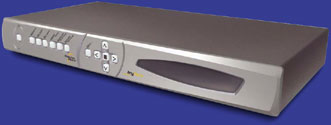It used to be that truly high-quality video, the pristine jaw-dropping images previously available only to the “Golden Eyes” of Hollywood post production and broadcast facilities (and anyone else with a spare $60,000 to spend), was simply beyond the bounds of the typical home theater. But Silicon Optix intends on changing all that with the introduction of their new Realta with HQV single-chip video processor.
According to Paul Russo, chairman and CEO of Silicon Optix, the new Realta chip is the result of three years of collaboration between Silicon Optix and Teranex, a leading supplier of Hollywood quality image processing solutions for the broadcast, post-production, and high-end home theater markets. (Silicon Optix acquired Teranex in late July of this year.) Jed Deame, Teranex’s co-founder, says that “Realta’s HQV technology matches, and in many cases exceeds, the industry leading video processing seen in the $60k Teranex 3RU Xantus system, dramatically raising the bar for home theater picture quality”.
Combining Teranex’s trillion operation-per-second broadcast-quality video processing with Silicon Optix’s proprietary geometric scaling technology, the Realta chip is claimed to “create a new standard for image quality”. Silicon Optix is referring to this as “Hollywood Quality Video” (HQV). When Teranex uses the term “broadcast quality”, one can presume that they know what they’re talking about. Teranex video processors are used by numerous post production and broadcast studios including NBC, CBS, ABC, FOX, WB, and Turner networks.
The benefits of cramming all this technology onto a slim piece of silicon not much larger than a pair of Andes after-dinner mints is two fold. First, as you might guess, is cost. Although pricing hasn’t been publicly released, it’s quite obvious that the Realta chip will add significantly less than $60,000 to any HDTV, DVD player, or other video device that it will be included in. Dennis Crespo, Silicon Optix’s vice president of marketing, says “As the Realta chip is integrated into home entertainment products the HQV logo will rapidly come to be synonymous with the very finest video display quality possible”. Crespo recently informed Home Theater Magazine that the first announced design using the Realta chip will be from Algolith. The box-based product will be called “Dragonfly” and is expected to ship in the first quarter of 2005, with an estimated MSRP of $3,500.
The other advantage is full programmability. Unlike the majority of hard-wired video processing chips on the market today, the Realta chip’s programmability allows device designers to optimize image quality for different types of display technologies – and manufacturers can, if they so choose, design products using the Realta chip to be field upgradeable to keep pace with new technologies.
Here’s a brief rundown of some of Realta’s HQV processing:
- True 1080i to 1080p/QXGA De-interlacing uses the full four-field processing window for HD video de-interlacing and cadence detection.
- SD/HD Multi-Direction Diagonal Filter (MDDF) using a true 10-bit diagonal interpolator to remove “jaggies” and/or stair-stepping artifacts without blurring the image.
- Noise Reduction for pixel-by-pixel noise and motion measurement to reduce analog and MPEG noise from DVD and broadcast sources.
- Detail Enhancement improves image detail on a pixel-by-pixel basis for SD that approaches HD quality.
- Automatic Film Mode Cadence Processing provides industry-first support for “Vari-Speed cadences” such as 3:2:3:2:2 (commonly used for movies broadcast on TV) as well as numerous others to ensure film and video sources will be seen in the original format without loss of resolution. HQV technology is the first to offer 3:2 insertion at HD – a requirement of both HD Blu-Ray and HD-DVD formats.
- Automatic Per Pixel Video/Film Detection makes pixel-level decisions for processing film pixels as film and video pixels as video to avoid processing artifacts that occur in sequences such as video titles or movie credits over film backgrounds.
- 16 to 1024-Tap Adaptive Scaling maintains highest image quality when up- and down-scaling.
- True 10-bit Processing enables rendering of over 1 billion colors.
- Equal Quality Two Channel Processing provides and industry first-processing of two full-resolution channels of HD or SD.
 Previously, Silicon Optix was best known to the video gurus at Home Theater Magazine for their amazing Image AnyPlace Video Scaler with Image Geometry Correction capability that allowed installers to compensate for picture geometry problems arising from unusual projector alignment requirements. The Image AnyPlace device also allowed for images to be projected onto cylindrical, spherical, or even completely irregularly shaped objects. (And I vehemently deny that I ever suggested we do a test of the product using the top of Video Editor Geoffrey Morrison’s head).
Previously, Silicon Optix was best known to the video gurus at Home Theater Magazine for their amazing Image AnyPlace Video Scaler with Image Geometry Correction capability that allowed installers to compensate for picture geometry problems arising from unusual projector alignment requirements. The Image AnyPlace device also allowed for images to be projected onto cylindrical, spherical, or even completely irregularly shaped objects. (And I vehemently deny that I ever suggested we do a test of the product using the top of Video Editor Geoffrey Morrison’s head).
